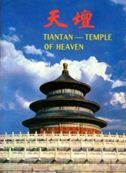Tiantan Temple of Heaven
Publisher:
China Esperanto Press
Publication:
1/1997
Languages:
English
Binding:
Paperback
ISBN/SKU:
9787505200715
Pages:
80
Sizes:
257 x 185mm
Weight:
0.3500
In Stock (Only 3 copies left)
To be dispatched within 1 business day
To be dispatched within 1 business day
Special Price
£11.34
£11.34
Regular Price
£11.95
(€12.70)
Located in the southeast of Beijing, Tiantan is where emperors of the Ming and Qing dynasties worshipped heaven and prayed for a good harvest. It is the largest existing temple Structure in China and is known far and wide for four sites: 1. Qiniandian; 2. Huiyinbi (echo Wall); 3. Sanyinshi; 4. Huanqiutan. Its exquisite design, skilful architecture and unique style are rarely found in ancient world buildings, making it a must for visitors to Beijing. Tiantan was built in the 4th through the 18th years during the reign of emperor Yongle of the Ming dynasty. In the early period of the temple, because heaven and earth were worshipped together, it was called Temple of Heaven and Earth. In 1530, another structure Fangze (the Temple of Earth) was built on the northern outskirts of Beijing for the worship of earth and since then, heaven and earth were worshipped separately. The original Temple of Heaven and Earth was used exclusively for the worship of heaven, so it was renamed the Temple of Heaven. The Temple of Heaven covers 273 hectares. The structures were laid about in the shape of the character and the temple wall was divided into inner and outer parts. The outer altar wall is 6,416 metres long. Originally there was only a western gate, through which the emperor went in and out to worship and the current east, west, south and north gates were later opened. The inner alter wall is 3,292 metres long and set up with east, west, south and north gates. The main buildings of the Temple of Heaven are concentrated in the south and north axis of the inner altar and are connected by the Danbi Bridge. From south to north are Huanqiutan, Huanggongyu, Qiniandian and Huangqiandian. There is a Zhaigong in the west of the temple, a Divine Kitchen and a Butcher Pavilion in the east: an Echo Wall. a linked area of 72 rooms and Qixingshi and other structures and scenic spots.
This picture album consists of three parts. For the readers' convenience, we begin with the Fasting Palace where the emperor worshipped heaven, then proceed to introduce Qiniandian and Huanqiutan, interspersed with some interesting legends and anecdotes. The picture album is laced with elegant pictures and concise language and, at the same time, easy to read. It will provide enjoyment to visitor, architectural researchers and the casual readers.
This picture album consists of three parts. For the readers' convenience, we begin with the Fasting Palace where the emperor worshipped heaven, then proceed to introduce Qiniandian and Huanqiutan, interspersed with some interesting legends and anecdotes. The picture album is laced with elegant pictures and concise language and, at the same time, easy to read. It will provide enjoyment to visitor, architectural researchers and the casual readers.




